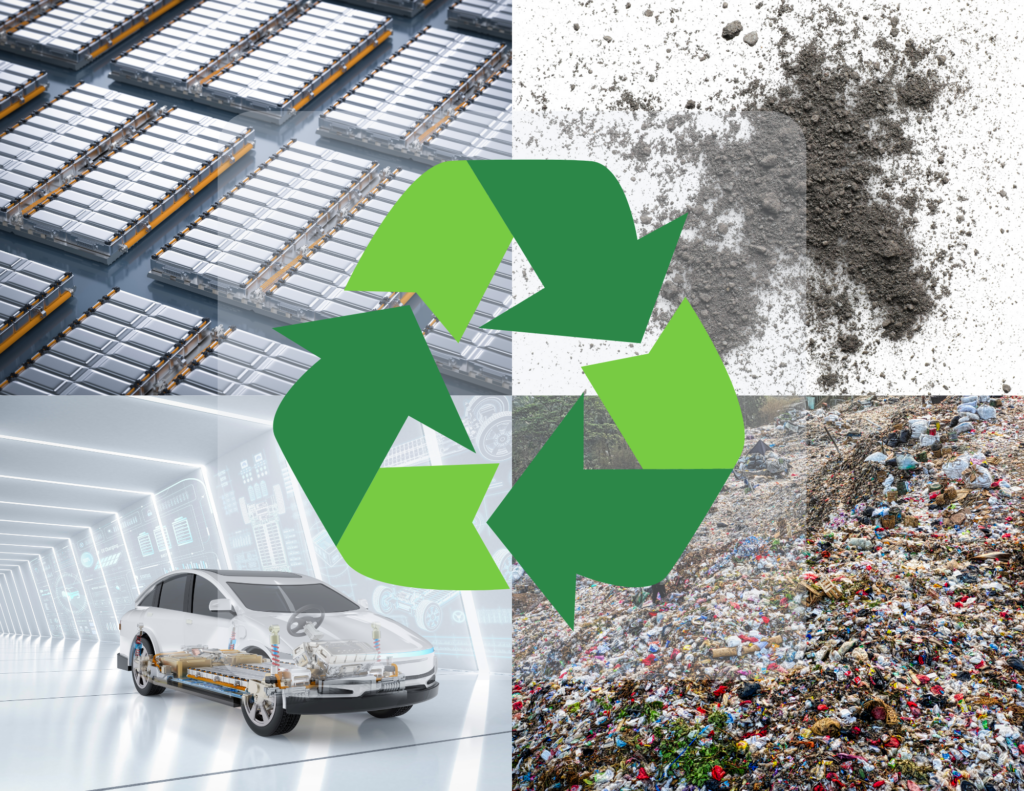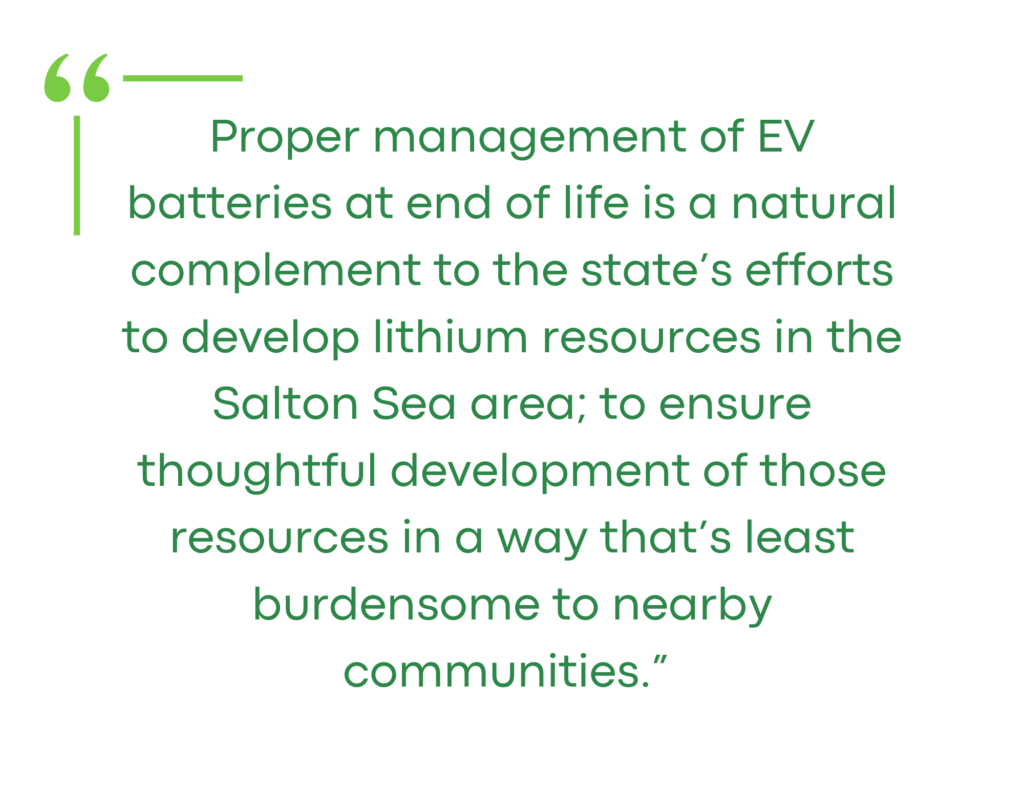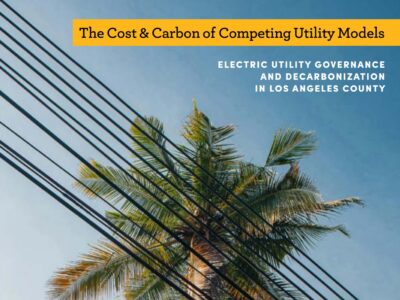We Need a Circular Economy for EV Batteries
California got close to making suppliers ensure EV batteries are managed responsibly at end of life. Here’s why 2025 should be the year California creates a circular economy for EV batteries.

California continues to make significant headway toward its target to eliminate in-state sales of new internal combustion engine vehicles by 2035. About one in five new cars sold in California are battery-powered. And it’s not just California: Battery-powered car sales are up globally, with projections showing 17 million will be sold worldwide in 2024.
As EVs proliferate, so will demand for the critical minerals that power their batteries. But mining for those elements can have serious health and environmental consequences for nearby communities. And ever-increasing numbers of battery-powered cars on the road will also mean a growing number of waste batteries. EV batteries have a lifespan of 10 to 15 years and are typically only under warranty for about 8 of those. Imagine tens of thousands of potentially hazardous lithium-ion batteries entering the U.S. waste stream in coming years. We’ve seen what happens in other industries when the waste stream isn’t responsibly managed and their products clog landfills, whether that’s plastic bags or smartphones. California envisions a zero-emission vehicle future—which means it needs to get serious about what happens when an EV battery reaches the end of its life powering a car.
Luckily, state lawmakers are already on the case. This year, the Legislature passed SB 615 (Allen), an extended producer responsibility (EPR) bill that would have required EV battery suppliers to ensure batteries are managed responsibly at end of life. (UCLA Law students in the California Environmental Legislation Clinic were fortunate to get to do some research work to assist in the development of the bill.) Batteries would have needed to be reused, repaired, or remanufactured if they could be—and if they couldn’t be, they would have needed to be repurposed for other applications (like providing additional storage capacity for the electrical grid) or recycled so that their valuable component parts aren’t lost. The bill would have represented an important step forward to properly manage growing amounts of spent EV batteries—but despite its success in the Legislature, it was ultimately vetoed this September.
California, usually a leader, is falling behind in this space. China—where EV sales could represent 45 percent of new auto sales this year—has had EV battery recycling regulations on the books for almost 20 years and has taken significant steps in the last several years to promote an EPR program for EV batteries, with the goal of supporting a strong, homegrown EV industry. That investment has paid off: China’s BYD beat out Tesla last year to become the biggest EV manufacturer in the world. In Canada, British Columbia has already adopted a five-year EPR action plan for EV batteries, and in Quebec, which has devoted significant government investment to becoming a hub for EV battery manufacturing and recycling, EV manufacturers fund an end-of-life battery management scheme.

SB 615 represented a much-needed framework to ensure critical battery components aren’t wasted and batteries don’t become stranded, unmanaged hazardous waste. Proper management of EV batteries at end of life is a natural complement to the state’s efforts to develop lithium resources in the Salton Sea area; to ensure thoughtful development of those resources in a way that’s least burdensome to nearby communities, California needs robust rules in place to maximize the critical mineral resources already available in spent EV batteries. EPR programs have been successful models for hard-to-manage waste. And in this case, the market favors the very kind of repurposing, reuse, and recycling that SB 615 sought to promote—companies that the bill would have regulated, like Ford, came out in support of the bill, and no formal opposition was registered.
In vetoing the bill, the Governor cited concerns about the administrative burden that would be placed on the Department of Toxic Substances Control (DTSC) to manage the program. Under SB 615, DTSC would have needed to create regulations to enforce the bill’s requirements and to create a system to report battery transactions, to ensure batteries don’t end up orphaned. The Governor’s veto message gestures at another way of setting up EPR programs: a producer responsibility organization, or PRO (Sen. Allen’s landmark SB 54 enacted a PRO-based EPR program for single-use plastic waste). PROs are industry organizations, and PRO-based EPR laws task industry with coming up with their own plans to manage waste, subject to certain conditions and state oversight.
But PRO-based EPR programs can still come with significant government involvement—as they should. To ensure that a PRO-based EPR system is working properly, statutory language establishing the system should provide direction about the PRO’s parameters and responsibilities and should create multiple points of engagement for the oversight agency. SB 54 is a great example of this: While producers are ultimately responsible for coming up with plans to manage their products at end of life, the law provides robust direction about how the PRO should be organized and various conditions its planning efforts must meet, requires agency oversight of plans and ongoing reporting, and tasks the agency itself with categorizing waste streams and analyzing the existing waste management landscape to ensure producer plans hit the mark.
A PRO-based structure is certainly an option for an EV battery EPR system, but in the context of EV battery recycling, SB 615’s structure made good sense and wouldn’t overburden the agency. There are a limited number of battery suppliers in the state, but their business models differ enough that housing all suppliers under one PRO could present challenges. Allowing for multiple PROs or producer plans would increase the amount of agency oversight needed to review initial plans, ensure their implementation, and conduct ongoing reviews into the future to determine whether industry proposals need adjustment. And even in a PRO-based system, the agency would ideally still provide regulatory direction to guarantee that the EPR law’s objectives were met. By contrast, tasking DTSC with developing a compliance framework up front could actually eliminate some long-term administrative burden by prescribing clear standards regulated entities need to meet and then enforcing them. And SB 615 would have created a mechanism whereby industry would fund these regulatory costs, so the state would not bear the burden of providing resources to manage the program.
SB 615 would have been an important step forward for California as increasing numbers of battery-powered cars on the road will generate a growing amount of EV battery waste. The bill’s structure was well-designed to address this issue—but regardless of what EPR structure the state lands on, fast action is needed. To make the most of EV batteries and their component parts, and to establish a circular system before the number of battery-powered cars on the road overtakes internal combustion engine vehicles, 2025 should be the year that California gets an EV battery EPR law on the books.
Reader Comments
2 Replies to “We Need a Circular Economy for EV Batteries”
Comments are closed.






Electric vehicles have no effect on climate and do not mitigate climate change at all. For the educated public there is no compelling justification for additional costs and other inconveniences of owning a battery vehicle.
As demand for EVs continues to decline more waste batteries will go to landfills or other repositories for worthless junk.
EV have about 1/4 – 1/3 the climate impact of equivalent gas cars (in the current system where the electrical grid is only partially decarbnonized). See: https://www.co2everything.com/co2e-of/tesla-model-y-awd-2020